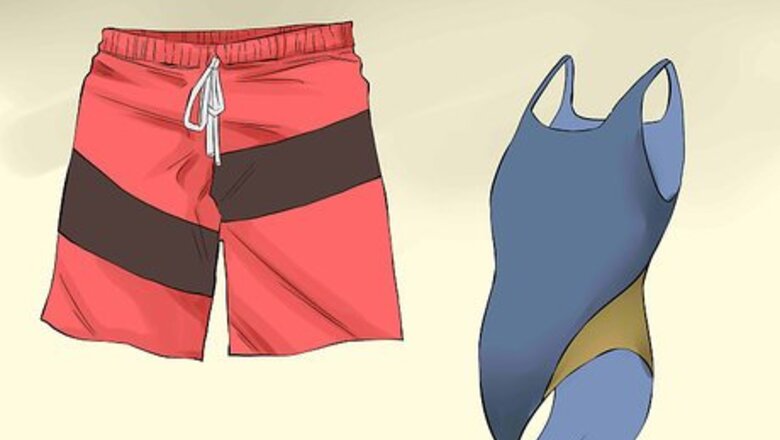
views
Getting the Right Gear
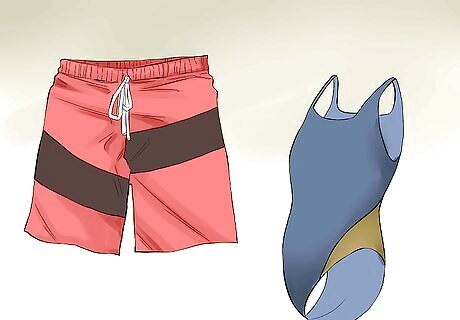
Get a proper bathing suit. Find a suit that is comfortable, fits well, and that you can move in. It shouldn’t fall off if you jump in the pool. Leave the embellished bikinis and baggy swim trunks for the beach or pool; you need something that is streamlined and easy to move in. Be extra cautious about the color white. Depending on the lining, it can be see through when wet.

Put a swim cap on. Not only will it protect your hair against the chlorine, but it will also make your body more streamlined and reduce water tension. If you have long hair, be sure to tie it up first, and then tuck it under the cap. Some swim caps contain latex. If you are allergic to latex, read the label, and make sure that you purchase a latex-free swim cap.

Buy good goggles that will not leak. Nothing ruins a swim faster than water in the eyes. Get goggles that fit over your eyes, and make sure that they are comfortable. Never get ones that cover the nose and mouth. If possible, try the goggles on in the store before purchasing– if not, be sure to get goggles with an adjustable nose bridge. This will ensure a proper fit. If you normally require glasses to see, you may want to consider prescription swim goggles, which are not much more expensive than normal goggles. You'll be able to see your instructor clearly, and they can make your swimming experience more enjoyable. Some contain latex. If you are allergic to latex, be sure to check the packaging before you buy anything first; it will tell you whether or not it contains latex.
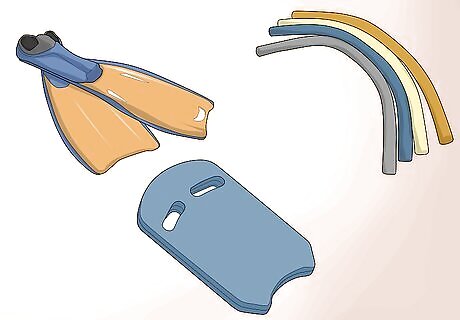
Consider getting some other swimming supplies. Many people find that items, like pool noodles, kickboards, and flippers help them with various aspects of swimming. If your swim teacher recommends these items, then you might want to consider buying them as well. You can also purchase nose plugs and ear plugs to prevent water from getting into your nose and ear. If you are swimming in an outdoor pool, be sure to get sunscreen.
Learning to Breathe
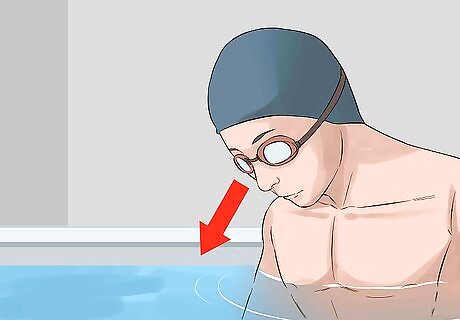
Get comfortable with putting your face in the water. Make sure your goggles are on. At this point, you may need to adjust the goggles by tugging on the straps so that they don't leak. If you don't feel comfortable getting into the pool yet, you can practice this part in a bowl of warm water. The bowl should be twice the size of your face.
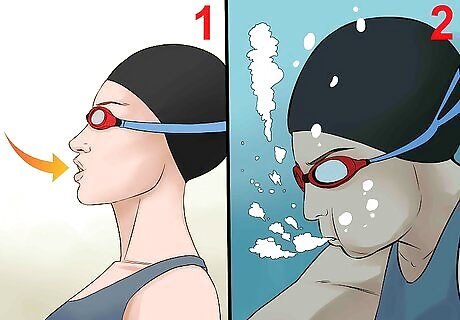
Practice inhaling and exhaling. Take a deep breath through your mouth first, then place your face into the water. Exhale slowly through your mouth, just enough to keep water from entering your mouth. Some swimmers like to exhale through both their nose and mouth. If you find this to be more comfortable for you, then you should do it. Some swimmers find that wearing a nose plug helps them exhale better underwater.

Keep your exhaling slow. You should take twice as much time to exhale as to inhale. If you find this difficult to keep track of, try timing your exhalation to the count of ten.
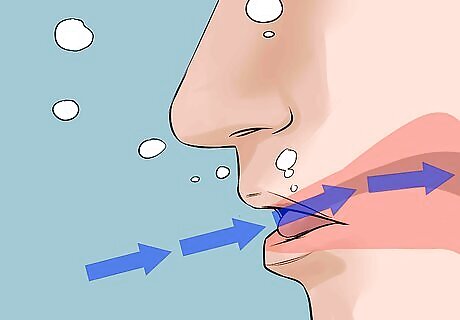
Relax while lifting your mouth out of the water to breathe and having your face in the water. You will likely get water in your mouth at some point while you are underwater. While this may feel uncomfortable, it is not a near-death experience. It happens to a lot of people, especially when they are first learning how to swim. One way to reduce swallowing water is to position your tongue as though saying "Keh."
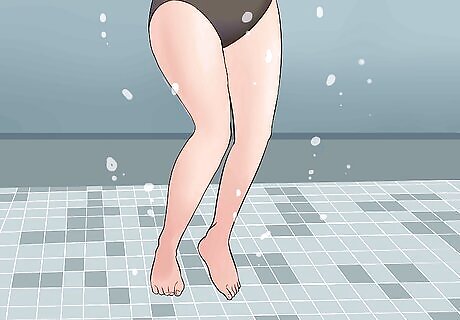
Remember to keep your focus on the bottom of the pool. Even though you are not swimming yet, this is a good practice to get into. It will help keep your body straight and aligned. If you keep your head out of the water, your body will be tilted upwards, and create more drag and resistance. It will make it harder to swim. If your pool has those black lanes, use those as a focal point.
Gaining Confidence in the Water
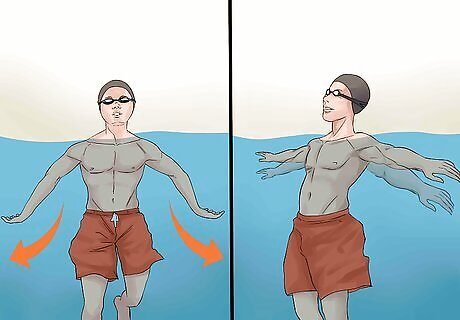
Get in the water, and move your arms sideways and up-and-down. You'll feel the pressure of the water resisting you, and you may even find it shifting your body around. Moving your arms sideways will cause your body to turn. Pushing downward will cause your body to move upward. moves your body up. Moving your arms backward will tilt your body forward. You can do this standing or sitting, but you should be in the water up to your shoulders. This is sometimes referred to as "sculling."
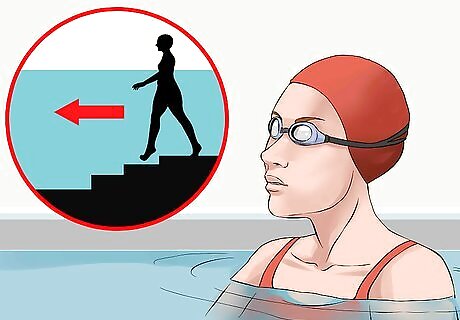
Move into slightly deeper water, where you can still stand. Make sure that your head is out of the water.
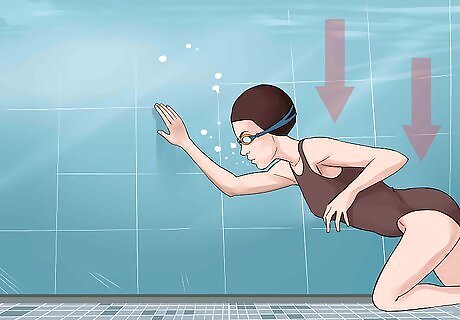
Hold on to the wall and start bobbing up and down. Use your feet to push off of the pool's floor, and remember to breathe out through your mouth.
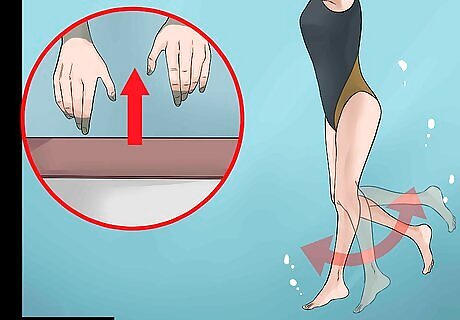
When ready, bob and release your hands from the wall. Push off the bottom with your feet to come up and grab the wall. Scull and kick while coming up.
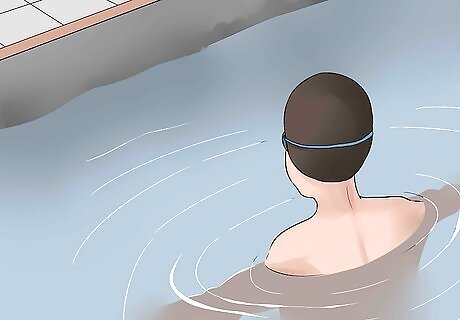
Keep doing this until you feel comfortable being in the water without holding onto the pool's edge. If you want, you can even step away further from the pool's edge. Remember to go no deeper than where you can still stand. This way, if your confidence fails, all you have to do is stand up.
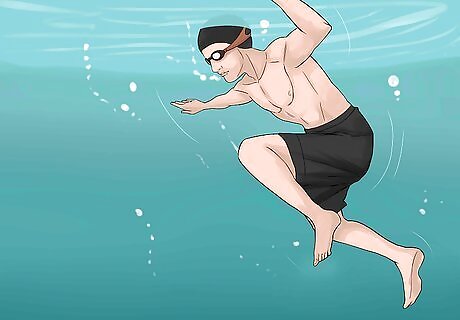
Play in the water until you feel comfortable and relaxed. Become accustomed to having your face in the water and your body stretched out. Try to reduce your dependence on using a flotation device and being afraid of going underwater. You can even swim a little underwater before coming up. Your primary reaction in the water must be to stretch out on the surface, scull, kick, breathe and relax. Don't get discouraged if you accidentally swallow some water. It happens to everyone, even experienced swimmers.
Learning to Float and Move
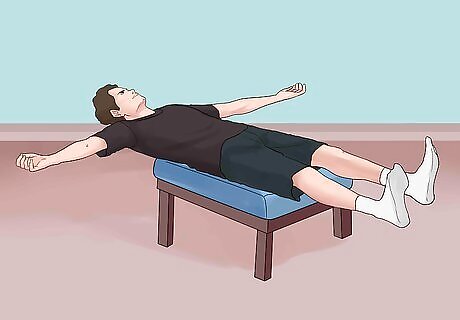
Get into the habit of keeping your body straight, like a needle on water. If your hips are lower than your shoulders, your body will tip upwards, and you won't be able to stay afloat. You can practice this by trying to balance on a bed, bench, or chair.
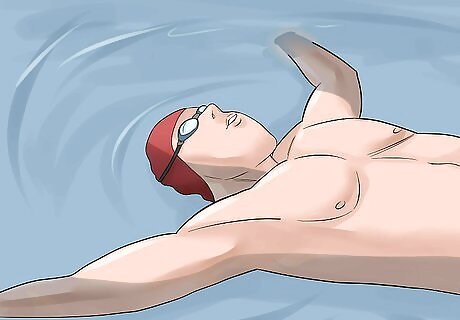
Try floating on your back first. Try to keep your body as straight as possible, with the back of your head between your shoulder blades. Move arms to your side and wave your hands, palms down, away from the hips. This will help you stay afloat and move around. Back floating is one of the easiest ways to learn how to float. If you are having trouble with this, get someone who is experienced in swimming to help you get into position.
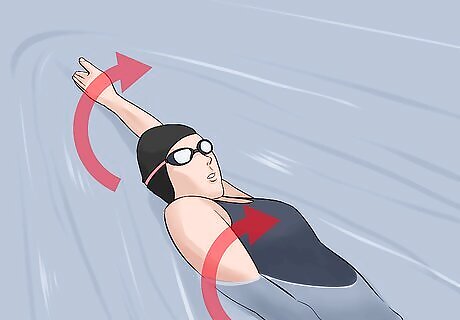
Roll your body slightly side to side and turn your head to the side to breathe. Face down to exhale, then turn over onto your chest and stomach. This is the body position for most swimming styles, including freestyle and breaststroke.
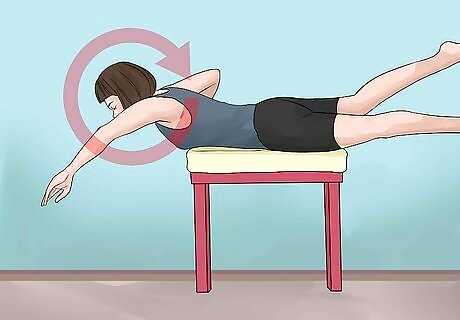
Practice your arm strokes. You can do this in the water, or on a bench/chair. Move your arm behind your head, over your head, and out in front of you in a circular motion.
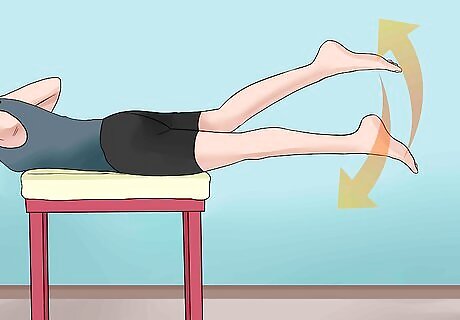
Practice your flutter kicks. Hold onto the side of the pool, a pool noodle, or a kickboard, and gently kick your legs in a soft, flutter-like motion. Try to keep your toes pointed, and your legs as straight as possible. Don't kick from your knees or kick too hard, as this will create too much drag and slow you down. This is the basic kick for swimming, be it on the back or face down. Your kicks should be low effort. Harder kicks won't necessarily make you go faster. You can also practice your kicks while balancing upon a bench.

Hold a kickboard or noodle, stretch out with your chin in the water, and kick. Go for 5 to 10 yards (4.6 to 9.1 m) while dipping face in the water to exhale. Do a few laps like this until you get comfortable. You can go the first length keeping your face out of the water, but try to work your way up to where you can swim with your face under the water. This way, you will be able to practice breathing. You may also find it easier to swim! Start practicing in shallower waters until you feel comfortable, then you can move on to deeper waters. Once you feel confident, try it without the kickboard, and add the arm movements.
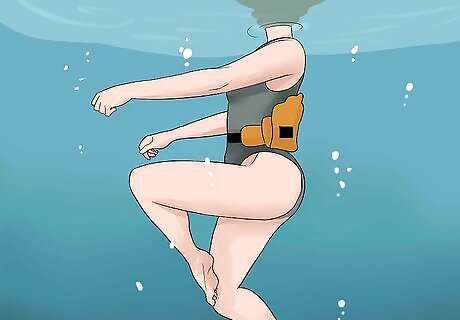
Use a water exercise or flotation belt around the waist while improving your skills. It is a great form of exercise to use after you learn to swim. This can be done while treading with the belt on. You can also wear swimming fins while practicing your kicks. Don't wear them all the time, however, especially for warm-up and warm-down exercises.
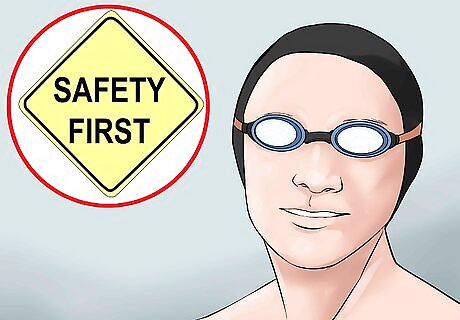
Remember to stay safe at all times. Learning how to swim is not a competition; save that for when you are more experienced. Don't force yourself to move into deeper waters if you don't feel comfortable at your current depth. If you feel tired, take a break, and get out of the deep end. Everyone started with the basics, so don't feel discouraged by the experienced swimmers around you. They will not think less of you or make fun of you. After all, they were in your position at one point too.



















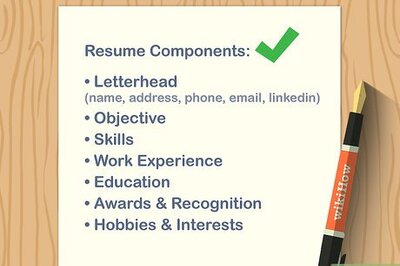
Comments
0 comment